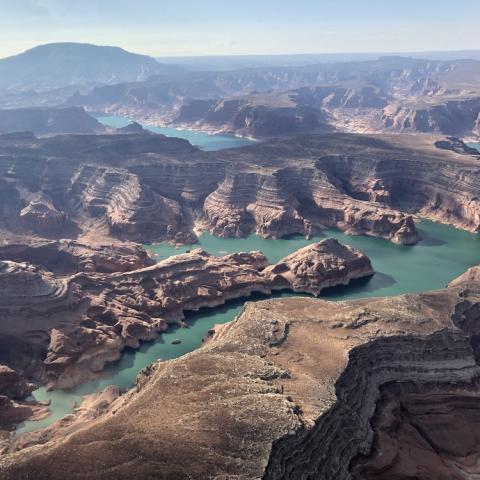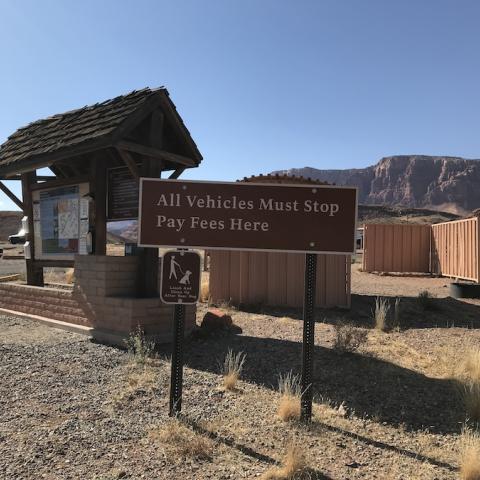
Lake Powell's dropping water levels are making it hard to launch larger vessels/NPS file
National Park Service crews at Glen Canyon National Recreation Area in Utah and Arizona are chasing the declining waters of Lake Powell by extending boat ramps at two popular marinas on the lake.
The affected marinas are Wahweap in the south and Bullfrog in the north.
These projects will achieve the park’s objective to maintain visitor access to Lake Powell during low water conditions by providing at least one boat ramp in the south lake area and one in the north lake area, the park said in a release.
U.S. Bureau of Reclamation projections for Lake Powell show lake levels dropping below the current reach of boat ramps in both the south portion and north portion of the lake by the end of July. Boaters with large vessels, particularly houseboats, are already reporting difficulty launching and retrieving vessels under current conditions at all available boat ramps. Additional ramp closures and restrictions are being implemented and will remain in place until ramp extension projects are accomplished or water levels increase.
South Lake Powell
The park has already installed temporary boilerplate ramp extensions at Wahweap Main Ramp, but additional action is needed to maintain boater access throughout the summer and fall seasons. The NPS, in partnership with park concessioner Aramark, will begin work this month to rehabilitate and improve the legacy Stateline Auxiliary Ramp, located between Stateline and Wahweap boat ramps. Bathymetry and historical data show that the Stateline Auxiliary Ramp should provide continued access to Lake Powell at water levels as low as 3,450 feet once rehabilitation is complete. On Thursday the level as reported to be 3,556.97 feet.
Boaters are advised that due to declining lake levels, the limited usability of the Wahweap Main Ramp, and construction activities at the Stateline Auxiliary Ramp, it is likely there will be periods of time as soon as late July when there are no open boat ramps in South Lake Powell. During periods of full ramp closures, boaters will be unable to launch or retrieve motorized vessels. The NPS will attempt to avoid full closures to the maximum extent possible.
North Lake Powell
Current water levels are posing challenges for North Lake Powell boaters attempting to launch and retrieve motorized vessels at the Bullfrog North and Halls Crossing boat ramps. To address these challenges, the following restrictions and closures will be implemented.
Effective immediately, only non-motorized vessels and personal watercraft may use the Bullfrog North Ramp until temporary ramp extensions can be installed. Boilerplate temporary ramp extension materials are currently under construction and will provide 80 more feet of surface area for vessel launching and retrieval. Additional ramp extensions will be possible at this boat ramp with moderate site preparation and construction, providing access to North Lake Powell from Bullfrog, Utah, until water levels reach approximately 3525 feet. However, boaters should be aware that temporary full or partial ramp closures will continue to occur before and during ramp extension construction activities.
Houseboats and all other motorized vessels may continue to launch from the spur on the southeast side of the Bullfrog Main Ramp via temporary ramp extensions that are 25 feet wide by 80 feet long.
Due to lowering lake levels, the Halls Crossing Ramp will close to all motorized vessels on Wednesday, July 21. This ramp cannot be extended due to this area’s topography, and so will remain closed to motorized vessels until lake levels rise enough to reopen.
The Halls Crossing Ramp will remain available to non-motorized vessels (e.g., kayaks, canoes, standup paddleboards). Owners of non-motorized watercraft are advised to clean, drain, and dry their equipment to remove quagga mussels.
It is not possible to predict with certainty how water levels at Lake Powell will fall and rise in response to a wide range of factors. It is imperative that boaters check the park’s website about the status of preferred launch destinations before heading to the lake. Information is available 24- 7 on our website about Lake Powell’s fluctuating water levels and the status of water-based visitor services at this link: Changing Lake Levels - Glen Canyon National Recreation Area (U.S. National Park Service) (nps.gov).



 Support Essential Coverage of Essential Places
Support Essential Coverage of Essential Places






